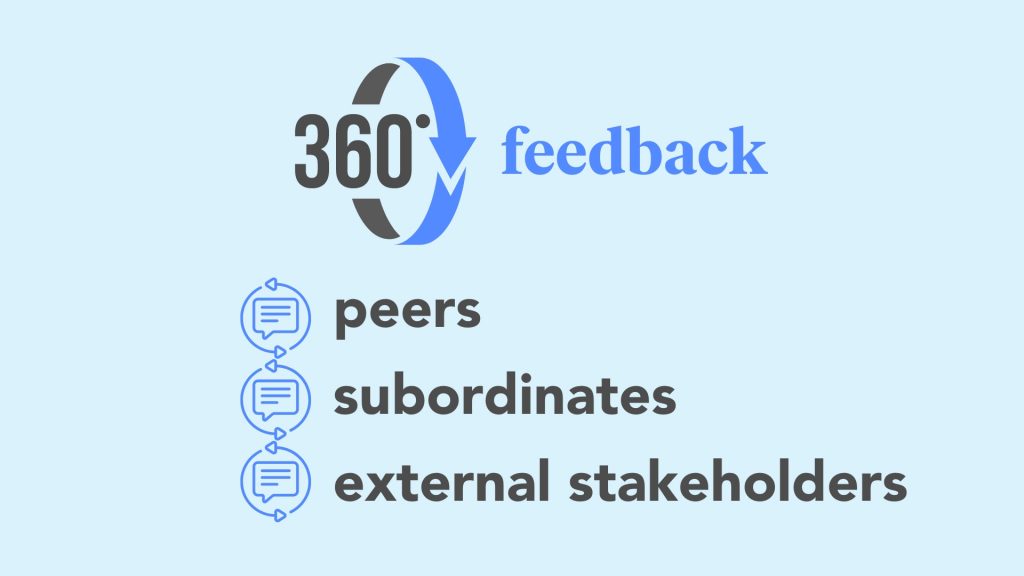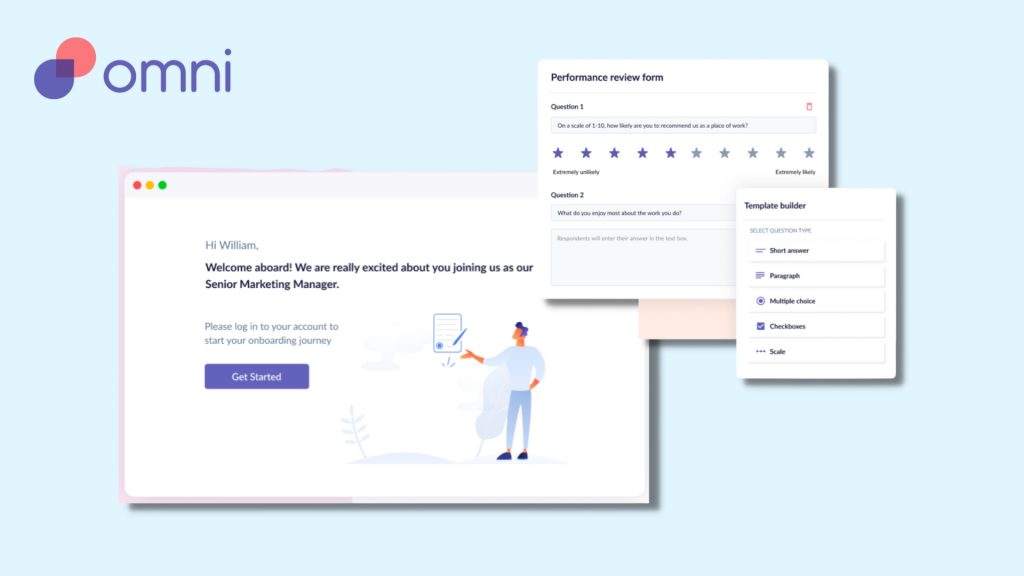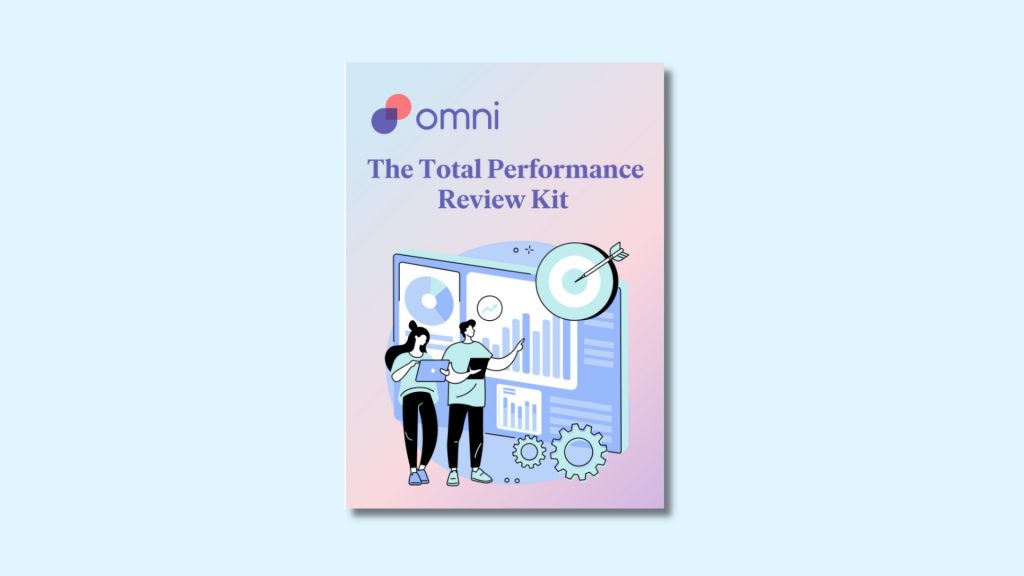43% of highly engaged employees receive feedback at least once a week. As companies work to hold on to their top talent, more organizations are recognizing the importance of implementing continuous improvement through fostering a culture of feedback.
360 degree feedback offers a panoramic view of an individual’s performance, unlocking insights that may remain hidden in a traditional feedback cycle. It provides a well-rounded assessment that considers diverse perspectives, enabling employees to gain a deeper understanding of their strengths, weaknesses, blind spots, and growth opportunities. This multi-dimensional approach not only fuels personal growth but also helps organizations create a culture of continuous improvement and collaboration.
That said, the implementation of 360 degree feedback requires careful planning, effective communication, and the right tools to ensure success. Here, we’ll break down the definition and importance of 360 degree feedback, along with actionable tips for managers to improve employee satisfaction with the feedback process.
360 Degree Feedback Defined

In traditional performance reviews, feedback primarily flows from superiors to subordinates, with limited insights from other sources. However, this one-dimensional approach often fails to capture a comprehensive view of an employee’s performance and development needs.
Recognizing this limitation, organizations have embraced 360 degree feedback to incorporate the perspectives of peers, subordinates, and even external stakeholders. By involving multiple raters, 360 degree feedback provides a more accurate and balanced assessment, helping individuals gain more thorough insight into their strengths and growth opportunities.
Peers provide insights into collaboration skills, team dynamics, and interpersonal relationships, shedding light on how your employees contribute to the overall success of the organization. Subordinates’ feedback offers insights into leadership and communication styles, as well as the ability to motivate and engage others. External stakeholders, such as clients or partners, provide a unique perspective on the individual’s professionalism, customer focus, and overall impact on business relationships.
The Benefits of Balanced Assessment

360 degree feedback offers several benefits for both employees and companies. By involving a diverse range of raters, it provides a broader perspective on performance and impact within the organization. This comprehensive feedback promotes self-awareness, encourages personal growth, and empowers your employees to take ownership of their professional development.
360 degree feedback goes beyond identifying areas for improvement; it also highlights an individual’s strengths and positive contributions. This balanced assessment approach recognizes and leverages individual talents while identifying areas where growth is possible.
By acknowledging strengths, employees feel valued and motivated to continue excelling in their areas of expertise. Simultaneously, addressing development areas ensures a well-rounded approach to professional growth and cultivates a culture of continuous improvement within the organization.
Best Practices for Impactful 360 Degree Feedback
Managers have to step into the role of feedback architects, crafting a personalized feedback journey for each employee.
Build a bridge of clear communication
By ensuring expectations are set and the purpose of feedback is illuminated, managers help construct a sense of purpose and meaning, transforming feedback from a formality into a catalyst for growth.
Be timely
Feedback is most effective when it’s offered in real-time. Through consistent and timely 1-on-1 meetings managers can review recent work or activities and provide targeted feedback that can be immediately adopted by employees.
Offer details
Feedback should be detailed and informative. Focus on specific strengths and areas for improvement.
Provide support
Offering resources, training, and mentorship for employees to develop skills and address identified areas of improvement demonstrates a commitment to their growth and provides employees with the tools they need to succeed.
6 Tips for Implementing 360 Degree Feedback
Implementing 360 degree feedback effectively requires careful planning, communication, and a strategic approach. With techniques like establishing a clear purpose, ensuring anonymity and providing training and guidance, you’ll create an environment that fosters growth, collaboration, and meaningful development for all employees.
Let’s take a look at these 6 actionable tips for managers to navigate the implementation process smoothly and maximize the benefits of a comprehensive 360 degree feedback program.
1. Establish a clear purpose
To ensure the success of the 360 degree feedback process, it is essential to establish a clear purpose and communicate it effectively. Clearly define the objectives and expectations of the feedback process to all participants. Emphasize that the assessment is intended for developmental purposes and aims to foster growth and improvement. By setting a clear purpose, employees understand the value of the feedback and are more likely to engage in the process wholeheartedly.
2. Ensure anonymity and confidentiality
To encourage honest and open feedback, it’s essential that you assure respondents their identities will remain anonymous. Anonymity promotes trust and allows individuals to provide genuine and constructive feedback without fear of repercussions.
Implementing a robust system that guarantees the confidentiality of responses is essential. This ensures a safe space for all participants to express their opinions openly, leading to more accurate feedback.
3. Provide training and guidance
To make the most of 360 degree feedback, it’s important to provide training and resources to both reviewers as well as those being reviewed. Train reviewers on providing constructive, unbiased feedback, emphasizing the importance of clarity, specificity, and fairness.
Also, offer guidance to recipients on how to receive feedback effectively, encouraging them to embrace it as an opportunity for growth. By equipping all participants with the necessary skills, you can ensure the feedback is delivered effectively and can be actioned on.
4. Integrate with performance reviews
While 360 feedback goes far beyond standard performance reviews, they remain an integral part of the process. By aligning the two, you create a cohesive approach to evaluating employee performance.
Incorporate the feedback received through the 360 degree assessment into your performance review discussions and use it as a basis for setting development goals. Integrating 360 degree feedback with performance reviews ensures a holistic and well-rounded evaluation, providing a broader perspective on your employee’s strengths and areas for improvement.
5. Foster a feedback culture
Creating a feedback culture is necessary for implementing 360 degree feedback. Encourage open and frequent communication across all levels of the organization, emphasizing the importance of feedback as a tool for growth and development.
You’ll also need to train managers and leaders to provide regular feedback to their team members and lead by example. By fostering a feedback culture, you create an environment where giving and receiving feedback is seen as a normal part of day-to-day operations instead of an intimidating once-in-awhile practice.
6. Encourage continuous follow-up and development discussions
Encourage managers and employees to have regular follow-up conversations to discuss the feedback received, address any areas of improvement, and set goals for development. These discussions provide an opportunity to delve deeper into the feedback, clarify any misunderstandings, and create a plan of action for personal and professional growth.
By promoting continuous follow-up and development discussions, organizations foster a culture of learning and improvement. It demonstrates the commitment of both managers and employees to utilize feedback as a catalyst for growth, leading to meaningful development and enhanced performance over time.
Tools for Implementing 360 Degree Feedback
Implementing 360 degree feedback can be a complex and time-consuming task. Leveraging tools to automate and digitize the feedback process can provide considerable time savings and help streamline the process. Luckily, there are a variety of tools organizations have access to that make collecting and actioning feedback easier than ever.
Omni
Performance reviews are an essential function of the 360 feedback process. Omni makes it easy to schedule, design, and run performance reviews for your entire team. With seamless data collection for tracking feedback, Omni’s analytics help you make better-informed decisions, with fewer tedious, error-prone manual tasks. Omni’s robust reporting and analysis capabilities, provide valuable insights to guide coaching and development efforts, and our automated communication platform makes it easy for HR teams to follow up on deadlines and incomplete review cycles.

Feedbackly
Feedbackly provides customizable surveys and questionnaires to collect feedback from different stakeholders, including superiors, peers, and subordinates. The platform offers various feedback formats, such as multiple choice, open-ended, and rating scales, enabling a comprehensive assessment. Feedbackly also provides real-time analytics and reporting, allowing managers to gain insights and track progress over time.
Qualtrics 360
Qualtrics 360 is a feedback and insights platform that offers comprehensive solutions for implementing 360 degree feedback. It provides a range of survey templates and questionnaires designed for multi-rater assessments. The platform allows you to set up feedback cycles, manage participants, and automate reminder emails to ensure timely responses. The platform also provides tools for action planning and follow-up, allowing organizations to pursue continuous improvement.
TruScore
TruScore is a dedicated 360 degree feedback platform that offers a suite of assessment and reporting tools. It provides customizable survey templates and questionnaires tailored to different roles and industries. TruScore enables flexible feedback workflows, allowing participants to provide feedback in a convenient and secure manner. The platform also offers comprehensive reporting options, including individual and group reports, radar charts, and benchmarking capabilities.
Make 360 Degree Feedback Simple with Omni
360 degree feedback is a powerful approach for organizations to enhance growth, development, and collaboration.
By embracing diverse perspectives and gathering feedback from multiple sources, individuals gain a comprehensive understanding of their performance, strengths, and areas for improvement. This holistic approach to feedback not only empowers employees to take ownership of their professional growth but also cultivates a culture of continuous improvement within their organization.
With Omni, managers, employees, and the HR teams that serve them can take full advantage of 360 degree feedback and its many benefits. Omni simplifies the entire performance review process, making it easier for managers to customize performance review questions, schedule performance review cycles, and run performance review cycles. With our user-friendly interface and intuitive features, Omni ensures a seamless experience for both participants and administrators.
Omni’s performance review solution integrates seamlessly with the 360 degree feedback process, allowing you to consolidate feedback from various sources and present it in a comprehensive format. Our platform ensures anonymity and confidentiality, encouraging honest feedback from all participants for you to leverage for performance improvement.
Book a demo with our team today to learn more about how Omni can streamline your performance review processes.
Not ready to leverage automation in your performance management but still looking to improve your strategy? Check out our free Total Performance Review Kit for all the tools you need for a comprehensive performance review program.



